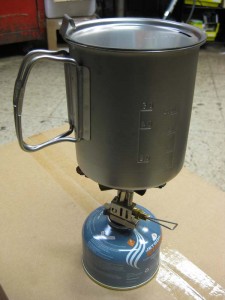
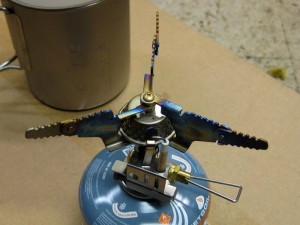 Picked up a little canister stove at the Snow Peak store in Shiroishi while in Sapporo. Most Snow Peak stuff is available on the USDM, but after the first year, Snow Peak USA removed this particular item from their product listing, though you may still find remaining stock here and there. I’m not really sure what’s up with that. All the specifications and information is readily available online, so I’ll just go over some of the things I noticed. It is really small, but it isn’t particularly light. I only say this because I picked up the aluminum-bodied Ultralight version. Granted the ultralight doesn’t have an igniter which means you have to add weight elsewhere by carrying a lighter or matches.
Picked up a little canister stove at the Snow Peak store in Shiroishi while in Sapporo. Most Snow Peak stuff is available on the USDM, but after the first year, Snow Peak USA removed this particular item from their product listing, though you may still find remaining stock here and there. I’m not really sure what’s up with that. All the specifications and information is readily available online, so I’ll just go over some of the things I noticed. It is really small, but it isn’t particularly light. I only say this because I picked up the aluminum-bodied Ultralight version. Granted the ultralight doesn’t have an igniter which means you have to add weight elsewhere by carrying a lighter or matches.
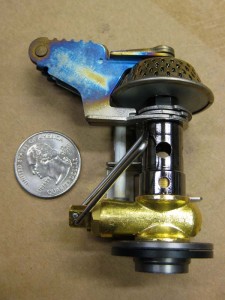 The stove is made in Korea, as are the other stoves in the Micro Max line. This isn’t documented anywhere online. I think Backcountry’s site said it was made in China, which is incorrect. “Made in Korea” is a non-issue, since most canister gas stoves, whether household or outdoor, are made there, along with the canisters themselves. I am not sure where the original Snow Peak Gigapower stoves are manufactured. The build quality is very good, and the materials sturdy.
The stove is made in Korea, as are the other stoves in the Micro Max line. This isn’t documented anywhere online. I think Backcountry’s site said it was made in China, which is incorrect. “Made in Korea” is a non-issue, since most canister gas stoves, whether household or outdoor, are made there, along with the canisters themselves. I am not sure where the original Snow Peak Gigapower stoves are manufactured. The build quality is very good, and the materials sturdy.
I bought a small, 100-gram fuel canister from a large chain sporting goods store for $5 USD plus tax. It wasn’t a genuine Snow Peak, but it was from another major outdoor stove manufacturer, and contained a similar isobutane/propane mix. I didn’t check, but all the different manufacturer’s canisters probably come from the same one or two factories in Korea. Although the stove instruction sheet expressedly forbids using other manufacturer’s canisters, I’ll go out on a limb here and say I’m pretty sure it’s OK to use another reputable manufacturer’s canister. The stove threaded on smoothly and easily, and the base valve made a brief hiss as the stove mated with it then fully seated. I opened the throttle valve a little and gave the igniter a click, and the stove instantly came to life in one try. No problems. Adjusting the idle is a little touchy, since you’re working in the range of about an eighth-turn of the valve, but since the valve operation is so smooth, it is pretty easy once you get used to the operation of the valve.
I took the stove outside, fired it up, and put a Snow Peak Trek 700 titanium pot with cover on it. The pot contained 500ml of room temperature water on it. This being Hawaii in winter, room temperature was in the 25 – 27C (78 – 81F) range, and this test was being performed at just above sea level. With the power turned up to the highest point where the flames were still even then backed down a little, the water started showing bubbles at around three minutes, and was at a rolling boil in four. Snow Peak estimates the total burn time with this stove on their small 110-gram canister to be around 22-minutes, so you can get around 5 rounds of fully boiling 500ml water out of one. That’s around $1 USD per boil which is easily more than white gas, but my intended use of this stove is light use on short trips in first-world countries, say for example a one or two night hike in Japan, or backcountry coffee while snowboarding in Canada. If I buy one canister on arrival, that’d be enough for the trip. It is uncommon to find white gas in quantities of less than a gallon in North America (although I’ve seen it sold that way in Japan). It’s a bit of a waste to buy a whole gallon and only use one MSR fuel bottle’s worth and ditch the rest.
In the aftermath of heating, the lid handle became warm, but could be handled without worry. The pot handles were a little warmer, but could still be touched without gloves. It would probably be a good idea to be conscious of the wind direction and not put the handles on the downwind side to keep them cooler. What did get hot was the wire bail on the stove throttle valve. I don’t think direction had anything to do with that. This heat was just from proximity to the burner, and possibly the reflected heat off the bottom of the pot. The low mass of the pot meant that once the burner was extinguished, the water began to drastically cool immediately, unlike a household pot where there is a larger heat reservoir in the mass of the metal. Take this into consideration when you are getting prepped for either rehydrating something or brewing coffee. Decanting the boiling water into a vacuum cup or bottle immediately, or brewing coffee into such a container will preserve as much of the heat as possible.
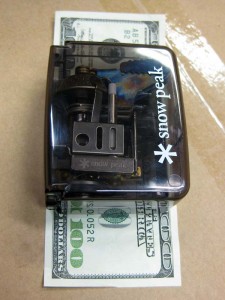 The stove comes with a little plastic protective case. This is nice so the stove doesn’t scratch up the inside of your pot if you store it inside. The dimensions of the case, however, prevent it from fitting in the Trek 700 in the “flat” orientation – it will only fit in upright. This means you can’t put both a small fuel canister and the cased stove inside the pot. A canister and the stove without the case will fit easily, but you’ll have to wrap the stove in something so it doesn’t rattle, get damaged, or scratch up the inside of the pot. I’ll probably make something out of high-density closed-cell foam or Kydex. A neoprene pouch would work too. The cased stove will easily fit “flat” inside the larger Trek 900 titanium pot. I don’t have a large canister on hand, so I am not sure how the fit will be in a 900 height-wise.
The stove comes with a little plastic protective case. This is nice so the stove doesn’t scratch up the inside of your pot if you store it inside. The dimensions of the case, however, prevent it from fitting in the Trek 700 in the “flat” orientation – it will only fit in upright. This means you can’t put both a small fuel canister and the cased stove inside the pot. A canister and the stove without the case will fit easily, but you’ll have to wrap the stove in something so it doesn’t rattle, get damaged, or scratch up the inside of the pot. I’ll probably make something out of high-density closed-cell foam or Kydex. A neoprene pouch would work too. The cased stove will easily fit “flat” inside the larger Trek 900 titanium pot. I don’t have a large canister on hand, so I am not sure how the fit will be in a 900 height-wise.
Overall I’m happy with the purchase, although I would have rather gotten it at the old USDM MSRP price, which was about $10 USD less.
7980-yen
Highly recommended
Four out of four techno monkeys
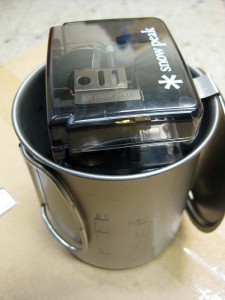
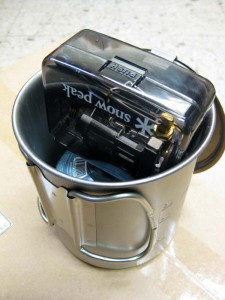
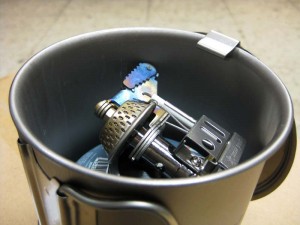
0 Responses to “Snow Peak Gigapower Micro Max Stove Titanium”